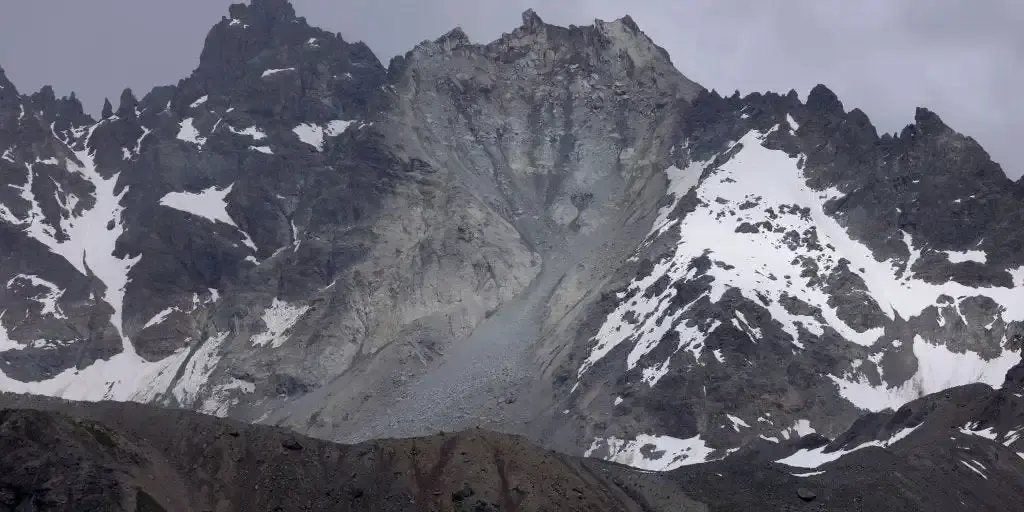- cross-posted to:
- switzerland@lemmy.ml
Mt. Fluchthorn’s tallest peak, on the Swiss-Austrian border, collapsed in June.
Experts say peaks in the European Alps and Southern Alps of New Zealand are at risk of collapse, too.
The damage and dangers from mountain collapse disproportionately impact indigenous communities.
On June 11, the main peak of Mt. Fluchthorn, on the border of Austria and Switzerland, collapsed without warning.
Roughly 3.5 million cubic feet of earth tumbled down, filling the valley below with 40 Olympic swimming pools’ worth of rocks, mud, and dirt, LiveScience reported. While no people got hurt, a religious cross marking the summit was destroyed.
Fluchthorn had three peaks, and the main, southern one used to be the tallest. With the south peak collapsed, the middle peak is the new summit at 11,145 feet — the second-highest summit in the Silvretta Alps.
Overall, Mt. Fluchthorn is 60 feet shorter than it was earlier this year, per LiveScience.
Why did the peak collapse? Well, like many mountains in the far north, Fluchthorn had a lot of permafrost — a permanent layer of ice and dirt under the mountain’s surface.
“Permafrost is important because frozen water within the ground holds the ground surface together and prevents it from moving. But when that ice melts, the liquid water can flow away. The ground surface becomes less stable and can move, often very quickly,” said Jasper Knight, a geoscientist at the University of Witwatersrand in South Africa.
When a big chunk of mountain moves quickly, like with the mudslide at Fluchthorn, that’s called a mass movement.
“Global warming is causing the permafrost to melt, which is the trigger for these mass movement events to take place,” Knight said.

But the situation isn’t hopeless. Scientists believe if we work now to slow down climate change and prevent mountain degradation, we can still stop the worst outcomes from happening and help protect the planet’s mountains and the communities that live near them.
I hate it so much when articles end like this. 1) It’s something the journalist wants to believe, scientist would not start a sentence with “but I belive…” 2) yea but we don’t do anything like that, what we do is not enough and not fast enough, so no: the situation IS hopeless 😖

But when it is hopeless there is also no more incentive to do anything.

Style guides often tell journalists to avoid saying what someone “believes”, as you can’t know what’s inside someone else’s mind. We can only know what they say.
Scientists say if we work now to slow down climate change and prevent mountain degradation, we can still stop the worst outcomes…

ApparentlyProbably ChatGPT often ignores what style guides often tell journalists, it’s just a bad article 😒
- argv_minus_one ( @argv_minus_one@beehaw.org ) English13•1 year ago
Welp, that wasn’t on my Apocalypse Bingo card.

Swiss mountain collapse. New Zealand has mountains that might collapse.
And it’s primarily a danger to the indigenous people in South America.
Explained by a scientist from Africa.
Finally some actual world news.
This is the best summary I could come up with:
Roughly 3.5 million cubic feet of earth tumbled down, filling the valley below with 40 Olympic swimming pools’ worth of rocks, mud, and dirt, LiveScience reported.
Across the world, mountains with permafrost melt have shown larger and more frequent landslides, the Intergovernmental Panel on Climate Change reported.
Mass movements can also increase the risk of blocked roads, damaged farmland, and mercury contamination in local bodies of water.
Argumedo and Stenner said Andean indigenous peoples have an in-depth system of traditional knowledge to predict and cope with extreme weather conditions on the mountainside.
One strategy they use are agricultural terraces — step-like tiers of farmland set along the mountain’s slope — that “prevent soil erosion and landslides,” Argumedo said.
He added that for the terrace strategy to work, the top of the mountain needs natural pasture and native tree species to act as sponges for extra water.
I’m a bot and I’m open source!

How many m^3 are in a fucking Olympic swimming pool?

2,500-ish. Regulations only give a minimum pool depth (2m).

So there was about 100,000m^3 in the rock fall.
Thanks for the clarification but I wish they would report actual numbers.

They said 3.5 million cubic feet in the article, which you may not consider an actual number (cuz the imperial system is shit) but it’s convertible into cubic meters, which comes out to 99108.963m^3 so you were pretty close.

Am not a farmer but, doesn’t terrace farming lead to soil erosion and lead to more mudslides? Typically because most trees are removed along the mountain sides which would have larger root networks than crops?
A similar issue is going on in china with promotion of terrace farming and crop loss in recent floods.

Permafrost was holding a mountain together? I mean, I’ll defer to the “geoscientist” but that’s surprising.

No deaths but a graven image destroyed, hmm…

If permafrost melts, was it actually permanent to begin with?
The earth is a highly dynamic system but it exists on a time scale that we haven’t evolved to intuit. Coasts, mountain valleys, volcanic regions, fault lines. Not great places to live long term.

Those might actually be the best places to live but has drawbacks to sprawling settlements like modern cities.
River banks and other water bodies supported most civilizations for millennia despite risk of floodings. Valleys would typically be avoided for risks of diseases, water stagnation, etc but those are easier to construct modern buildings.
None of the places on the earth would be immune to the changes that happens in the scale you are mentioning.


